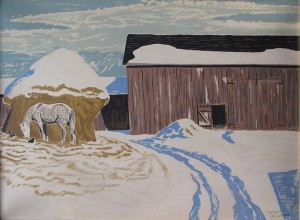When is a print more than just a print? The answer: When it’s a Sampson-Matthews silkscreen.
Prints aren’t as valued or sought-after by art collectors. However, Canadian art silkscreens produced by the Sampson-Matthews Ltd. company of Toronto from 1942-1963 hold a special place in the homes of many art collectors.
The silkscreens also hold a special place in the history of Canadian art and Canada.
The story is familiar to some, but not to others.
High-quality silkscreen prints showing the Canadian landscape were produced to be distributed to army barracks overseas and at home during the Second World War. The colourful pictures “of home” were meant as morale boosters. But the project also became a boon to Canadian artists of the day.
Group of Seven member A.Y. Jackson is given the most credit for pushing the project forward and winning the backing of the National Gallery of Canada. But it wouldn’t have been possible without the silkscreen production expertise of Sampson-Matthews Ltd., which was founded in 1917, and the commitment of co-founder Charles Matthews.
Large, 30- by 40-inch, silkscreens were made of works by late artists such as Tom Thomson and others, while other works were commissioned from prominent and not-so-prominent artists of the day (smaller, 20- by 27-inch versions were also later made).
The silkscreen process used up to 15 oil-based ink colours, depending on the original painting, meaning real paint was used in their production. Many of the colours were vibrant and bold. The silkscreens, laid over thick paper board, have stood the test of time amazingly well, many still looking vibrant decades later.
During the war, from 1942 to 1944, some 25 different silkscreens were made as part of a first series, with artists including A.J. Casson, A.Y. Jackson, Arthur Lismer (Isles of Spruce, 1943), Thoreau MacDonald, Sydney Hallam, Charles Comfort, James Wilson Morrice, Yvonne McKague Housser and others.
Another 11 silkscreens were produced from 1944 to 1945, including some by the same artists, such as Thoreau MacDonald (Winter Morning, 1944), and new artists such as Leonard Brooks, Fritz Brandtner and Albert Cloutier.
After the war, the project continued, with another 36 prints created in partnership with the National Gallery, with artists such as Alan Collier (Emerald Lake, 1950), Berthe Des Clayes (The Red Sleigh, 1950) and Tom Roberts. About another 15 were printed after the National Gallery withdrew in 1955, with a few more images printed by the Sampson-Matthews company up until 1963.
In all, about 100 silkscreens were produced in all, though the wartime series holds a more special place in Canadian art history.
These prints are credited with raising the national profile of Canadian art and artists, helping shape the Canadian identity in a wider way and with a wider audience than had been achieved decades earlier by the Group of Seven.
The prints not only found their way into army barracks; they found their way into classrooms, government buildings, business boardrooms and even homes across Canada. And many still survive in great condition even after 50 to 70 odd years.
Some silkscreens bear the words “Supervised by A.Y. Jackson” or, more often, “Supervised by A.J. Casson” above the printed signatures of the artist, though some of Casson signatures were added in the later years of his life. Some collectors seek out silkscreens with the handwritten signatures, believing they add value to the piece.
A.J. Casson worked as Art Director for the Sampson-Matthews company, while artists J.S. Hallam and Joachim Gauthier also worked there. Company partner J.E. Sampson was also an artist and contributed silkscreens to the project.
Jackson chose many of the pieces, but there was frequent debate with the National Gallery and others involved in the project about which paintings deserved to be reproduced. Some suggestions were rejected.
While it is unclear how many copies of various silkscreens were printed, it is clear that these Canadian artworks still hold a special place in our art heritage. The Sampson-Matthews silkscreens are still bought and sold at art auctions, by art dealers and by collectors. They’re cherished for their beauty, quality and their special place in Canadian art.
– Mark Skeffington, FineArtCollector.ca
Copyrighted material. Cannot be used without written permission.
To learn more about the Sampson-Matthews story:
- Joyce Zemans, Envisioning Nation: Nationhood, Identity and the Sampson-Matthews Silkscreen Project – The Wartime Prints, Journal of Canadian Art History, Vol. XIX: 1 (1998).
- Joyce Zemans, Sampson-Matthews and the NGC: The Post-War Years, Journal of Canadian Art History, Vol. XXI (2000).
- Sampson-Matthews Resource Site (website)

